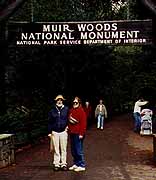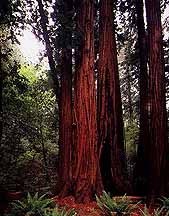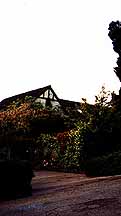American Sabbatical 042: 10/30/96
Muir Woods
10/30.. Muir Woods.
It rained again in the night and we awoke to a dripping world. The owl hoots and surf crashing
had faded with the night, and a fussy breeze was shivering the
junipers. We didn’t malinger in the dunes, but packed Red and
rolled south along the twisted highway.
More spectacular outlooks, but the vegetation along the road was
crowding out the grassland, and the settlements thickened. As
Sonoma yielded to Marin County you could almost feel the city
pulsing beyond the mountains. A couple of long inlets reach into
the hills along this shore, sending the coast road scampering
uphill to keep its feet dry, and you could look down into boat
basins jammed with yachts and fishing boats. But there still wasn’t
the sort of cottage density we’d expect. A few clustered towns,
the odd excessive edifice.
When the road veered away from the bluff shoreline it cut through
dry pastureland again, green in the bottoms, sear on top, and
crumpled like last night’s bedding. We were navigating toward
Bolinas, that storied town by Point Reyes, and the traffic was
picking up with haste. We’d dodge into the turnouts and let the
Californos slalom by in the intermittent rain.
Bolinas was hiding, and we were half a dozen miles beyond it before
we caught on. Turns out that every time the state put out a directional
sign the local boys would remove it. Got so the staties were camping
out with infrared snooperscopes to bag the offenders. Finally
the town voted to not have any signs, and the state shrugged and
went home. That kind of town. Most of the street signs are gone,
too, replaced here and there with handmade markers.
The whole burg looks handmade. Ownerbuilt imaginations girt in
redwood clapboard, shingle, board-and-batten, with flyingthis
and cantileveredthat, sprawled along the hillsides, all holding
up glass walls to the California sun. Doesn’t look like codes
enforcement has a heavy hand in Bolinas. The houses, generally
modest for all their phantasmagoria, hide behind redwood fences
engulfed in plantings. Vines, bushes, trees, shrubs in explosive
exuberance. The natives may be as reclusive as the town, or is
this just the Spanish style of courtyard architecture evolved
on a northern shore?
After a couple of false moves we found the downtown, maybe a dozen
commercial estabs in rickety frame buildings, backed up against
the south side of a hill. Sort of a seedy Camden, circa 1950.
Only it was more 1960s. A couple of hardcase types were hanging
out on the town bench, all heavy whiskers scowling brows and slept-in
clothes, but somehow I didn’t get the feeling they were homeless.
Just a pair of locals positioned to deflect any cutesy invasion.
The best defense against yuppification is some rough boys hanging
about. In fact you sensed that this wasn’t a low-rent town at
all, just dressed down to avoid gentrification.
It was dressed imaginatively, for sure, and as hirsute as you
could wish. We poked our noses into Smiley’s, the local bar and
boardinghouse of renown, but the smell of beer in the AM didn’t
do it for us, so we retreated across the street for a mugup. We’d
been told that Snarley’s and Scowley’s (long defunct) used to
be across the street from Smiley’s, and our cafe turned out to
have been the former. Nice to think that the sixties only left
smiles.
The breakfast crowd were all smiles. Everyone knew Steve Lerner,
who’d pointed us here, and they all joined in the converse. Just
like Bowdoinham, all restaurant talk is public. When we said we
were going to see Arthur Okamura we were told he placed third
in last night’s pool competition. This small town has survived
right under the foot of the giant metropolis by a strategy of
superficial hostility and seedy counterculturalism. A building
moratorium hasn’t hurt either.
Arthur Okamura lives surrounded by hummingbirds, and the whirring
of wings filled our heads as we entered his private garden. Arthur
is a Japanese-American artist, born and bred in Chicago, who was
interred during WWII. In the 1950s he settled in Bolinas when
it was a raw bohemian outpost. He attributed the epochal change
in town character to an oil spill in the early 70s which brought
squads of green youth to help rescue the threatened wetlands around
Bolinas. Apparently Standard Oil had provided puny containment
booms, so the locals and friends constructed massive log and straw
barriers, and spent weeks sopping up raw crude.
After the mess was cleared away the town had a reputation as an
altered-native kind of place, and longhaired inmigrants came to
stay. When cleanwater regulation was changing the politics in
Arcata, Bolinas went through political upheavals. Pinkolefty types
took over town government, and organic waste-treatment ponds were
created, instead of a sewage treatment facility. Watershed analysis
revealed there was only enough H2O to supply a limited number
of houses, so the town banned new construction. It does sound
as if water purification is the hinge issue on this coast.
Arthur’s hinges swung open to welcome us into his gracious hospitality.
A successful gallery painter whose wife runs a paper crafts shop
in Sausalito, Arthur is a model of what a West Coast life might
have been for us, in an earlier generation. He has walked the
line between abstract expression and representation, and calls
himself an abstract realist. The portrait of a swimming colleague
he was working on was all swirling water abstractions with a man
afloat in it. Arthur teaches in Oakland, this is his retirement
year, so he bowed us out on his way around the bay to class.
It was sopping down again, so we scuttled our plans to gambol
on the beach at Point Reyes, but we did wanted to take a look
at Commonweal HQ, where Lerner and Co. have done their creative
work, so we drove out to the old antenna farm where the Institute
lives. Is it true that radiofrequency emissions fiddle your brainwaves,
making you more creative? Should we stick the baby’s head in the
microwave? Stay tuned.
Commonweal is an alternative medicine think tank, best known at
present for providing a supportive, controlled environment for
people who choose alternative cancer treatments. Completely openminded,
the staff and institute document the various strategies and help
those in crisis to pick paths they feel are best. I would have
liked to talk with staff about the creative visualization carvings
I’ve been commissioned to make for cancer patients in recent years,
but the thought of being a tourist where people are fighting for
their lives kept us from barging in.
We turned round in the old array, some of which may still be keying
on Coast Guard freqs. It felt a lot like the antenna farm at Argentia,
Terranewf. Were we ahead of our times back there? Could a marconized
ambiance be the wave of the future? The Real Goods grid, the Commonweal
array, your local transmission towers.. are these totems of transforming
power? Hiss.
We drove round and about in Bolinas, gawking at the towers and
turrets and cliffhanging rusticity. Thought about booking a room
above the bar at Smiley’s and settling into the local scene. Any
place where one of the local ladies walks the street wearing burlap
sack pantaloons and a head-dress of rushes, carrying a forked
branch to punctuate her converse, has to be all right. But we
had promises to keep over the hill, and snuck out of town before
we sunk to our hubs.
| Arthur had recommended we climb over Mt. Tamalpais into Muir Woods,
so we put the Owl into low gear and twitched her tail-feathers.
Up on Mt. Tam we got tantalizing snapshots of San Francisco Bay
and islands through drifting cloud and fog, and switchtailed into
the deep pocket of the family woods. |

Muirs
|

Postcard
(Lynn Hunton Photo)
|
We’d driven all this way down the California coast without getting
any sense of impending urbanity, but the parking lot at Muir Woods
was full of tour busses and European suits, rented Camrys and
avoidance glances. Very strange to walk beneath the giants through
trailing scents of French perfume, encountering chic-costumed
clusters of aloof strangers, and the music of unknown tongues.
The undergrowth was thick here, as well, and you feel you might
turn a corner and be in Central Park.. but with plantings like
skyscrapers. A ranger crew was cutting up a downed sequoia, and
it was eerie to hear the snarl of a chainsaw and the thunk of
axes echoing among the leviathans. We smiled at each other and
whispered in a secret tongue, “Let’s split.” |
Uncoiling out of the big woods we dumped out into the dizzying
rush of freeway traffic, and it took us three tries to find an
exit for Sausalito. After reading the personals in Whole Earth
Review (nee Co-Evolution Quarterly.. Arthur did the first cover
for Co-Ev) all these years, it was imperative we get a grok at
Gate 5 Road, or the houseboat city, or something. But where Bolinas
took down the sign, Sausalito got swallowed whole. Bolinas may
dress down, but Sausalito dresses up, even to go pick up the paper.
Gunnel-to-gunnel yachts in the boat basins, and wall-to-wall designer
stores along the aves. Any counter-cultural air in this burg has
long blown over. We scoffed down Greek salads and halva in a middle
eastern deli, and bit the bullet.. time to beatwing into the hydrocarbons.
Next stop Berkeley.
We had a date to meet a family friend on Halloween in Berkeley,
but wanted to check out the proper costumes first. Naturally we
got lost in the glittering autobabble, but eventually found ourselves
spinning up University Ave in the rain, with the UC tower guiding
us to higher ground.
Peggy explained to me that higher means nobler in this kingdom,
and the bayshore flats are ignoble enough to make a case for her
thesis. Here’s the picture. A mountain chain running along the
coast, pierced by the Golden Gate. Sausalito sits on a narrow
shelf just inside the gate, to the north, while San Francisco
rears up and sprawls over the heights to the south. Once through
the narrow pass, the bay opens wide like Long Island Sound, but
with a rim of blue hills enclosing the waters and coastal flats.
Great bridges and causeways connect San Francisco with the industrial
cities surrounding the bay. We skirted the northern perimeter
of this basin, then rode over an engineering marvel to the Richmond-Berkeley-Oakland
mega-urb. Now we were on the long slope approaching the Berkeley
Hills.
UC Berkeley sits at the foot of the uplands, looking down on the
industrial peons, but beneath the superior beings on high. Actually
the college has a well-deserved reputation for democracy, and
the ethnic diversity on the streets and campus is broad and deep.
Homeless population and streetfreaks ditto. This is the capital
of free speach in America, and the babel is loud and clear. We
didn’t have to worry about costumes.
It was getting late in the daylight, what there was in the gray
day, but Peggy wanted to try and find the house she’d lived in
during ninth grade. So we quartered our way upscale. Leo had been
a professor, after all. The Berkeley Hills are the real California:
stucco and tile and pastels piled to the sky along impossible
slopes, intersected with rollercoaster roadways and glorious plantings.
Not the gigantic piles abuilding today, these are relatively modest
sized cots, and picturesque beyond telling. But there is zero
life on the street, non-automotive life, that is. Does everyone
live a life of quiet desperation behind these charming walls?
We didn’t despair, and finally found the vine-covered bungalow
on Bonny Lane, hiding under an immense evergreen. Peggy wandered
up and down the street in nostalgia while the Owl and I clung
to the hillside. The sun was breaking out as it set behind the
coast mountains and fog was rolling under the Golden Gate. Then
we loosed the parking brake and dove back into rush-hour.
|

Childhood Scene
|
We were aimed for a Motel6 in Pinole, north of Berkeley, out where
the industrial flats turn into malldom. We got turned around sideways
again, but we’re coming to expect that. The motel had hot and
cold running modem jacks, so we were content.


